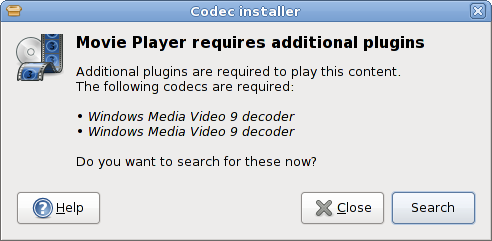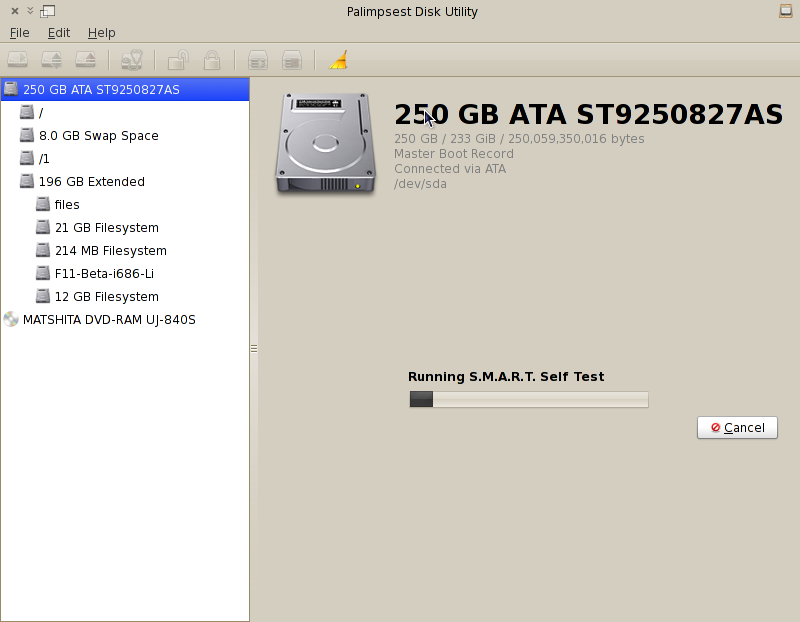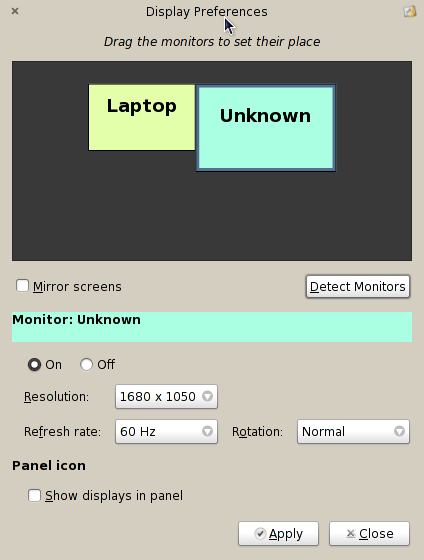With about two weeks for the final release I hear many talking about Leonidas. I hear ext4, faster boot speed, new volume control and a lot of things which I could not comprehend. So I read the Feature List page in the Fedora project wiki and decided to come up with features that one might want to look up before installing 11 on to the system. As usual I’ve been using 11 from beta stage and have update it all this while. It is stable, in fact I have not experienced any bugs . Talking of bugs, I hear they even have a new bug reporting system for the non geeks which will send reports automatically. Lets have a look at the features most prominently advertised first and then go to the less popular ones.
20 Second Startup: This says it all, but the 20 second start up is just to the login screen. But what it doesn’t say is the amazing way it boots up to the login screen. I have never seen this on any other distribution. It starts very smoothly giving the user a blue screen and it does not flicker a bit and smoothly changes to the login screen. My words don’t give it any justice, really the experience is as refined as a Mac OS X even better.
Ext4 file system and brtfs: There is a lot of noise about the Ext4 file system being the default not only in Fedora but also Ubuntu. So what’s the big deal about it. For the start ext4 can support disks of 1 exabyte and a single file can go upto 16 terabytes. On an ext3 the maximum disk size can be 16 TiB and the maximum file size 2 TiB and has a faster file system check so the server market should reap benefits from it. For the rest, we should notice generally better performance, and benefit from things like persistent preallocation when using updated torrent clients, etc. I have definitely seen a big difference in speed using a ext4 system. Brtfs may become the default file system for Fedora in a future release. It is the answer to ZFS in Solaris. It is definitely not suitable for day to day use but if you want to see the future file system add icantbelieveitsnotbtr at the installation prompt and you should be able to format your partition using brtfs. For more details about brtfs go to their wiki.
Volume Control: When I installed the beta looking at the feature list was impressed that I could connect my bluetooth head set and configure it with simplicity. But the installation didn’t get the job done. It detected my Jabra Headset, that is all. Then after a few updates, I was bowled!

All I had to do was pair it with my system and POP it shows up in the volume configuration. Simply brilliant. There are still a few bugs, like it detects it as a mono system but by the release day I’m sure it will be done or one will find a fix in the due course. The volume can be centrally managed here thanks to the pulse audio system. And if you do run into trouble setting your volume refer to my post on Volume / Sound problem in Fedora 11.
Firefox 3.1 & Thunderbird 3: I love Firefox but it loads pages slowly. It is annoying at times how slow it can be. Using my brother’s mac I saw the gulf yawning in between the speed of safari and firefox. I was planning to change to opera when along came 3.1. It has a new Java engine and loads pages a lot more quickly than 3.0. It is actually impressive. You can expect your browsing a lot quicker. That’s something I like about Fedora. They bring the latest of the software in a release. You don’t have to wait for another release to get it into the main repository. Firefox 3, OpenOffice 3.0, Firefox 3.1, Gimp 2.6, all of them put into the appropriate release. For us who like to be in the bleeding edge of the software end, Fedora should be the choice. Thunderbird 3 is also included, not in the Live CD but you’ll find it in the repository. It also has a lot of improvement over 2 which you can find here.
GNOME 2.6 and KDE 4.2: Of course you get the latest of the desktop environments also. KDE 4.2 is something to look out for. They have done a lot of improvements and is finally worth using. The GNOME users may not experience much of new features but for the Volume control. They haven’t left out XFCE, fedora comes with the latest release, 4.6.
Presto: This is a plug-in for ‘yum’. It enables delta rpm support in Fedora. Delta rpm is an rpm file which stores the difference between versions of a package. For example updating the open office suite would nearly take a 100 M download, using deltarpms you can save up to 60 % that is you’d download only about 40M. It is not enabled by default so you will have to ‘yum’ it.
yum install yum-presto
I installed the plugin and updated my system. Just see the output I got:
yum update
Loaded plugins: presto, refresh-packagekit
[text omitted]
Transaction Summary
================================================================================
Install 0 Package(s)
Update 20 Package(s)
Remove 0 Package(s)
Total download size: 101 M
Is this ok [y/N]: y
[text omitted]
Size of all updates downloaded from Presto-enabled repositories: 19M
Size of updates that would have been downloaded if Presto wasn’t enabled: 101M
This is a savings of 82 percent
That saved me 82 M. Wow…
Supported Architecture: Users should notice slight speed improvements as 32 bit x86 would be built for i586 by default and PAE kernel would be installed where appropriate. In layman’s language if you have a system with more than 4GB of memory you will be able to use it on a 32 bit system and not just 3.2 GB.
Automatic Fonts and Mime installer: With the introduction of Package Kit into the system of Fedora things have become very impressive especially in installing codecs. My previous post describes how additional codecs can be easily detected and installed with minimum configuration, very similar to that of Ubuntu.

In this release they have gone a step further. If you have a file which does not have an application to open, with the use of Package Kit Fedora would search an application to open the file:

And it does the same with fonts too:

DeviceKit: It is similar to HAL and it is to eventually replace it. It is a device management tool. One new software which is included in the devicekit is the Palimpsest Disk Utility. It checks your hard disk and notifies you the state of your drive.

It also checks the status of your disks at login time and provides fixes. You can do basic file system operation in it like deletion of partition or renaming a label and others.
X-server 1.6: With X-server 1.6 spanning desktop is a piece of cake. It wasn’t difficult to setup my 21inch Samsung monitor to span with my laptop.

One might notice you cannot kill X using Ctrl-Alt-Backspace which personally I miss. To enable it you will have to add Option “DontZap” “false” in the ServerFlags section of the xorg.conf file.
Fingerprint: Support in fingerprint is improved in this release. I personally do not have a system with fingerprint recognition so have not tested it. You can look here for further details.
Synaptics: This was one thing that tripped me off. When I installed Fedora at the beta stage I couldn’t just get tapping enabled by default. I was annoyed and even made a mention of it in my review. But later did I realise that with this release things were beginning to improve. Touch Pads can be configured with ease. If you are having trouble configuring your touch pad look here.
Kernel Mode setting for Intel Chipsets: With Fedora 10 Plymouth was introduced removing the good old rhgb. Plymouth brings about brilliant graphical boot screen and with kernel mode setting enabled in Intel chipsets you wouldn’t notice any change in graphic settings from the boot up to the login screen thus making the boot up very refined.
For developers 11 comes with Netbeans 6.5, Windows Cross Compiler, Python 2.6 and integrating Linux Tools OProfile and Valgrind into Eclipse IDE. Windows Cross Compiler is interesting as it enables programmers to build windows softwares right off their system.
Virtualization hasn’t been left off either. Virtual guests have improved graphical consoles with accurate mouse pointer and higher screen resolution. With SASL authentication introduced one does not require to tunnel through SSH to access VNC servers (VNC is been use to interact with QEMU remotely.) Kvm and QEMU have been merged into a single package which makes sure qemu does not lag behing kvm.
Underlying features that support the release are rpm 4.7, rewrite of anaconda storage, DNSSEC, DRI2 for better 3d support and compositing manager, gcc 4.4, IBus, improved interaction of GDM with PAM, update of the radeon r100/r200 3D drivers,Nouveau as default driver for NVIDIA graphic cards, stronger hashes and couple of others too.
This release has got me more excited than 10. The features as the wiki says it “dwarfs any other release”. It looks very promising and the future for Fedora seems brighter. It is definitely a brilliant milestone after 10 releases.





